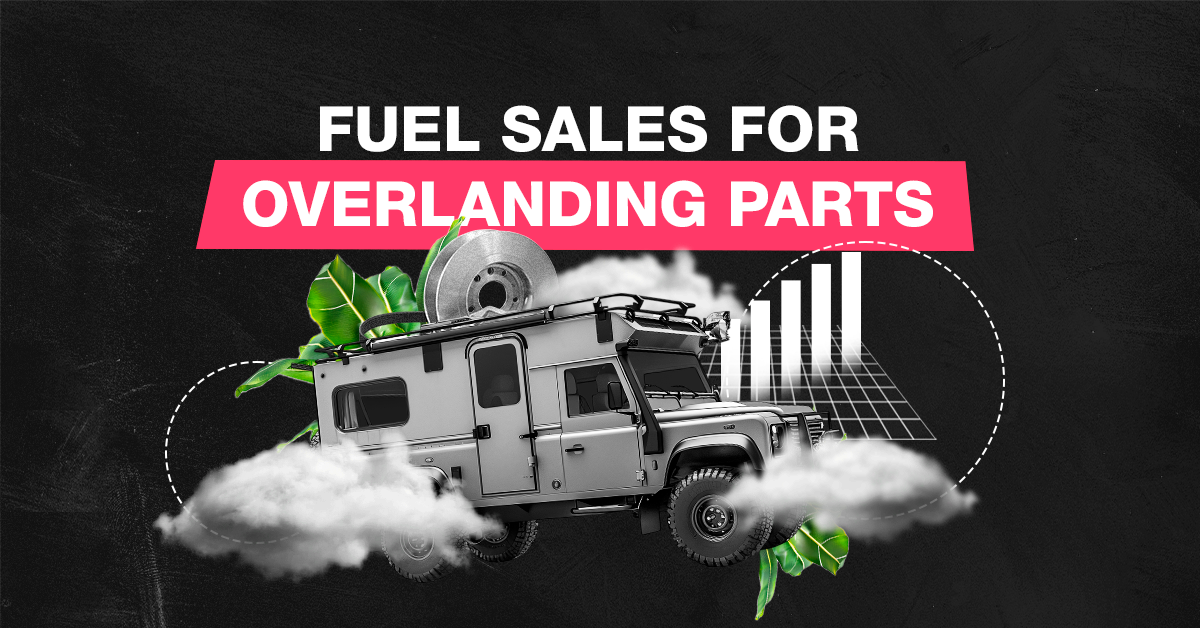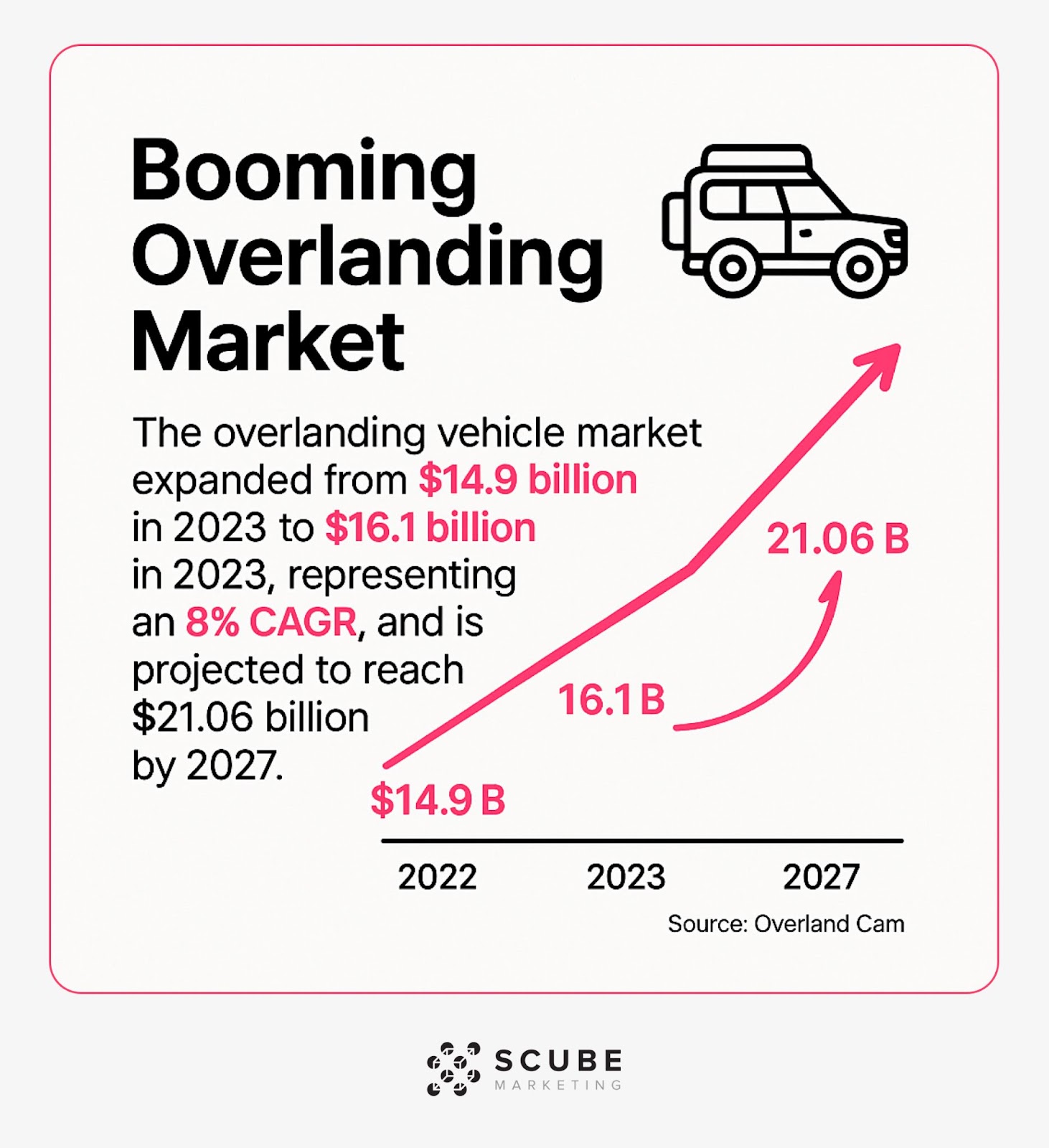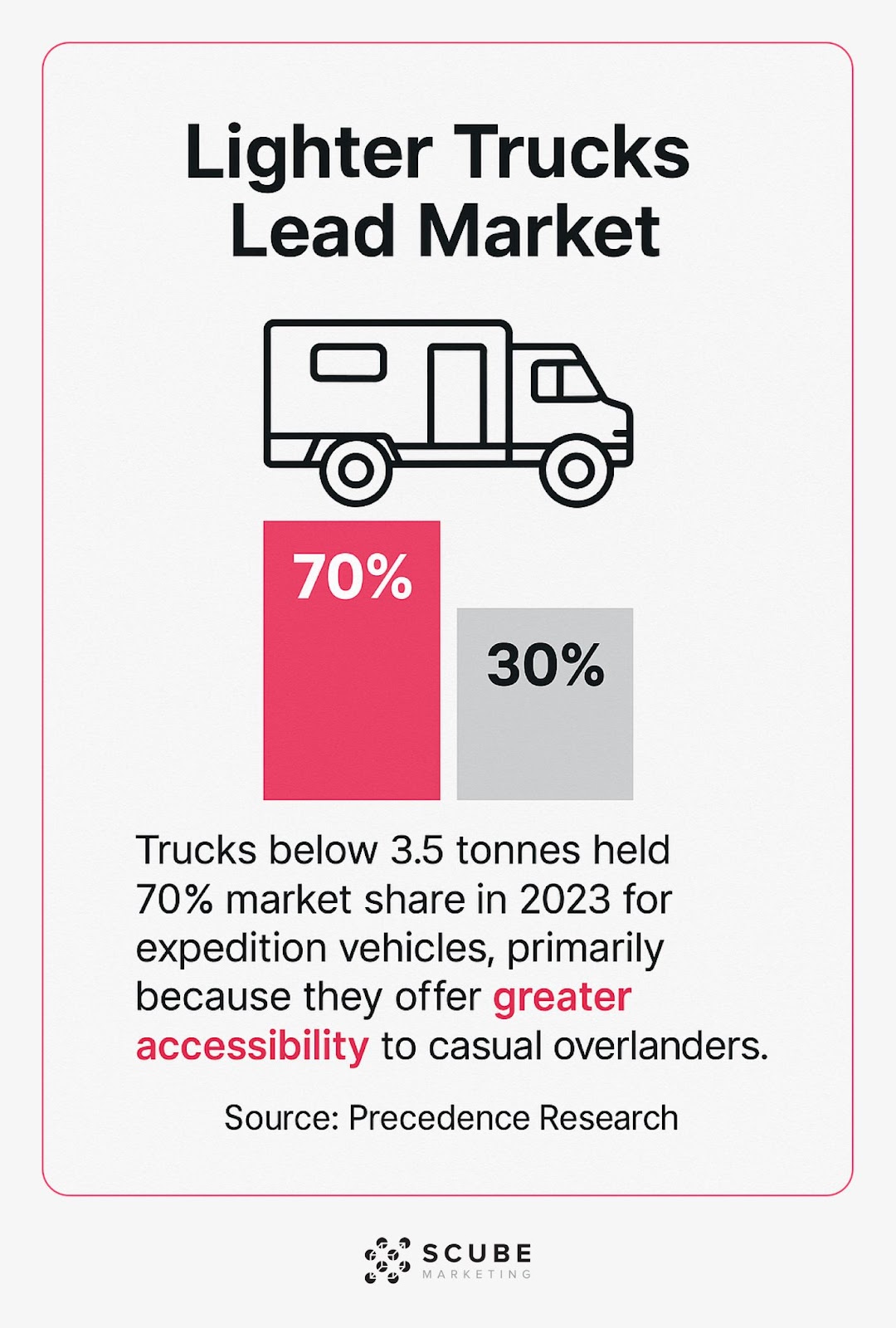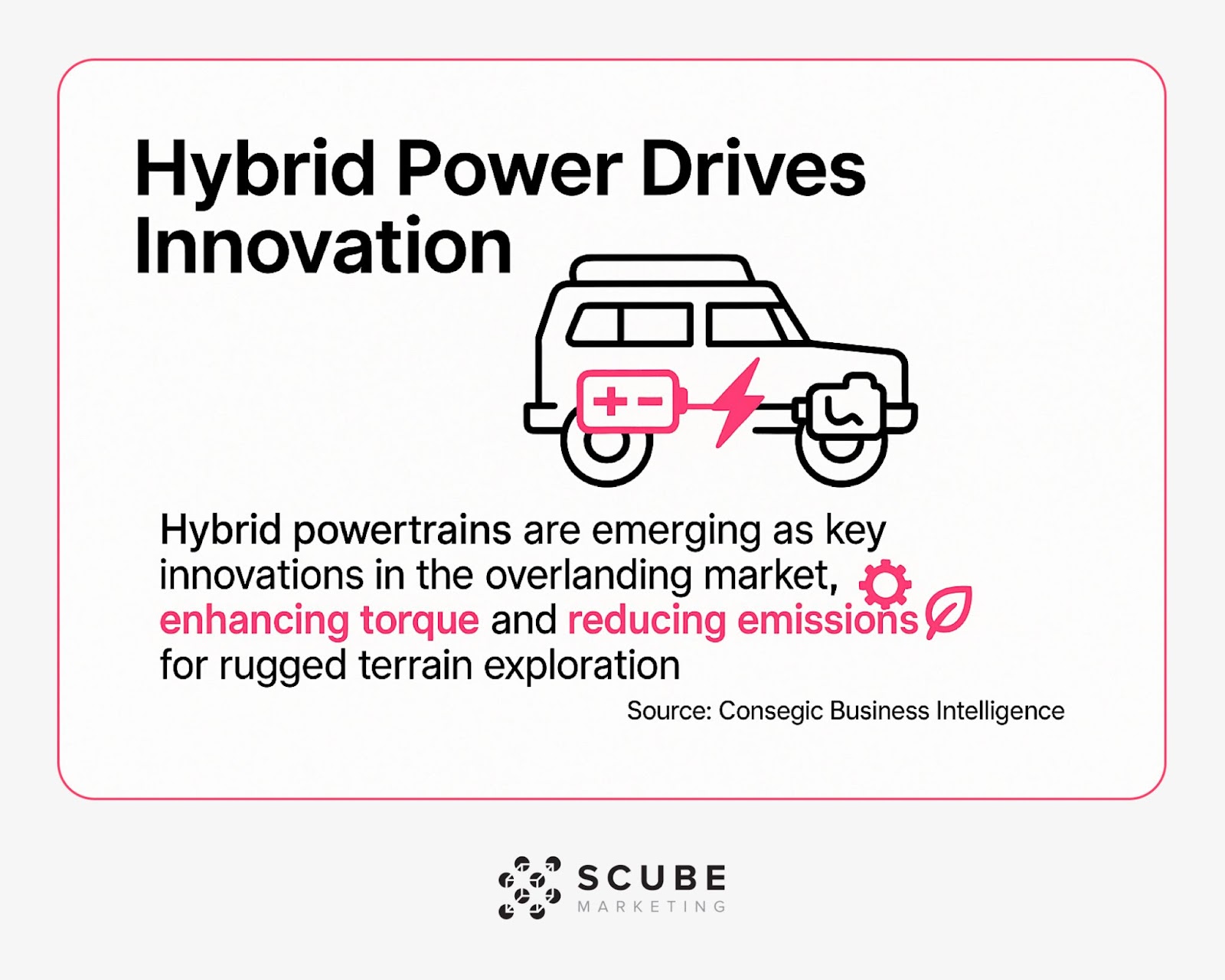
The overlanding market is booming. Adventure seekers are investing significantly in vehicles and parts that enable off-grid experiences. As someone who helps overlanding and aftermarket parts eCommerce businesses grow through targeted marketing, I've watched this space evolve rapidly. Reaching these enthusiastic customers requires specialized strategies that connect with their unique motivations and lifestyle aspirations.
Overlanding isn't just camping or off-roading—it's a distinct culture. These customers research extensively, value quality over price, and form strong brand loyalties. For parts manufacturers and retailers, this presents both challenges and opportunities for marketing effectively.
In this guide, I'll share actionable marketing strategies to help overlanding parts brands connect with their ideal customers. We'll examine market trends, digital foundations, search marketing tactics, social strategies, and measurement approaches that drive real results. Let's get started with understanding this unique market.
Successful marketing begins with market knowledge. The overlanding sector has shown impressive growth in recent years. Hard data helps us understand the scope of opportunity for parts brands targeting this audience.

The overlanding vehicle market expanded from $14.9 billion in 2022 to $16.1 billion in 2023, representing an 8% CAGR, and is projected to reach $21.06 billion by 2027. (Source: Overland Cam)
This strong growth trajectory creates significant opportunities for parts brands. Let's examine the specific segments and trends driving this expansion.
The overlanding market spans several interconnected segments. Each represents different opportunities for parts manufacturers and retailers. Understanding these distinctions helps target your marketing efforts more precisely.
Below is a breakdown of key market segments and their growth patterns. This data highlights where the biggest opportunities exist for parts brands.
The data reveals consistent growth across all segments. For parts retailers, the gear and accessories sector offers particularly attractive opportunities, having grown by 25% in 2023, driven primarily by demand for rooftop tents and portable refrigerators. (Source: Grand View Research)

Understanding which product categories drive the market helps focus your inventory and marketing efforts. Several distinct categories dominate the overlanding parts space.
Vehicle enhancement components represent a substantial segment. The 4WD systems dominated the expedition truck market with 60.1% share in 2023 due to their superior off-road capability. (Source: Market.us)
Vehicle size preferences also influence parts purchases. Trucks below 3.5 tonnes held 70% market share in 2023 for expedition vehicles, primarily because they offer greater accessibility to casual overlanders. (Source: Precedence Research)

Consumer preferences in this market show clear patterns. Overlanding vehicles and their parts are selected primarily for versatility (on/off-road use), lower maintenance costs, and better fuel efficiency compared to high-performance off-road models. (Source: Consegic Business Intelligence)
Marketing effectively requires understanding your audience. Overlanding enthusiasts represent a diverse but distinctive customer segment with specific characteristics that influence their buying decisions.
Regional distribution matters in this market. North America commands 52% share of the expedition truck market, fueled by strong adventure tourism trends and a well-established customization culture. (Source: Market.us)
Let's examine the major customer segments within the overlanding community. This breakdown helps target marketing messages more effectively.
Understanding these segments allows for targeted messaging. Each group responds to different selling points and content types. Your marketing should address their specific needs and pain points.
Success begins with a solid foundation. For overlanding parts brands, this means creating digital assets that resonate with adventure enthusiasts while driving conversions.
My experience with eCommerce clients has shown that specialized markets like overlanding require tailored approaches. Let's examine the core elements of a strong digital foundation.
Your website serves as your digital storefront. For overlanding customers, certain features are particularly important for driving engagement and conversions.
If you're looking to improve your automotive email marketing for aftermarket sales, the overlanding market offers unique opportunities for follow-up and retention.
Every overlanding parts website needs specific elements to succeed. These features address the unique shopping behaviors of adventure enthusiasts.
Implementing these features creates confidence. Overlanding customers research extensively before purchasing. Your website should facilitate this research process while guiding them toward conversion.
Mobile optimization is essential for overlanding parts retailers. Many enthusiasts research products while on adventures or during brief moments between activities.
Consider how overlanders use their devices. They often browse in challenging conditions with limited connectivity. Your mobile experience should accommodate these constraints.
Key mobile design elements include fast loading speeds, simplified navigation, and easy checkout processes. Test your mobile experience thoroughly, especially under conditions that simulate limited connectivity.
Your product catalog structure significantly impacts conversion rates. Overlanding customers think in terms of projects, vehicle systems, and adventure types rather than simple product categories.
Organize products in ways that match customer mental models. Group items by function (recovery gear, storage solutions) rather than just product type. This approach aligns with how overlanders plan their vehicle builds.
Below is a comparison of effective marketing channels for reaching overlanding customers. This data helps allocate your marketing resources efficiently.
This channel comparison highlights where to focus efforts. How to effectively sell auto parts online becomes even more important when targeting niche overlanding enthusiasts through these specific channels.
Search marketing drives significant results for overlanding brands. Both organic and paid strategies play important roles in a complete marketing approach.
Implementing data-driven strategies is essential for aftermarket auto parts success in eCommerce, particularly in the growing overlanding sector. Let's explore effective search marketing approaches.
Organic search visibility starts with keyword strategy. Overlanding enthusiasts use specific terminology when searching for parts and solutions. Your content should align with these search patterns.
Several keyword categories consistently drive traffic and conversions for overlanding parts. Focus your content strategy around these proven themes.
Content depth matters for overlanding SEO. Create comprehensive guides that address specific aspects of vehicle builds or adventure preparation. These in-depth resources establish authority and attract quality links.
Paid search complements organic efforts. For overlanding parts, PPC campaigns should target high-intent keywords that indicate active shopping behavior.
Focus on product-specific terms and include important qualifiers. Terms like "heavy-duty," "lightweight," and "compact" often indicate serious buyer intent in this market.
Ad copy should speak directly to overlanders' values. Emphasize durability, versatility, and real-world testing rather than just price. These qualities resonate more strongly with this audience.
Google Shopping can drive significant revenue for overlanding parts retailers. Product feed optimization is essential for maximizing visibility and conversion rates.

Hybrid powertrains are emerging as key innovations in the overlanding market, enhancing torque and reducing emissions for rugged terrain exploration. (Source: Consegic Business Intelligence)
Include vehicle compatibility information in product titles and descriptions. This helps your listings appear in fitment-specific searches, which often indicate high purchase intent.
Social media plays a crucial role in overlanding marketing. These platforms allow brands to showcase products in action and build community around shared adventures.
Understanding audience targeting strategies for social media will help you connect with overlanding communities more effectively. Let's examine platform-specific approaches.
Not all social platforms deliver equal value for overlanding brands. Focus efforts on channels where adventure enthusiasts actively engage with content.
The most effective platforms share certain characteristics. They support visual storytelling, community building, and detailed product showcases.
Content strategy should vary by platform. Instagram benefits from stunning visuals of products in use during adventures. YouTube requires detailed, helpful content that demonstrates product installation and performance.
User-generated content drives authenticity. Overlanding enthusiasts trust fellow adventurers' experiences more than brand-created content.
Encourage customers to share their experiences. Create branded hashtags, run photo contests, and feature customer builds on your website and social channels. This approach builds community while generating valuable marketing assets.
Provide incentives for content creation. Offer discounts, feature opportunities, or even free products to customers who create high-quality content featuring your parts in real-world adventures.
Community building creates lasting customer relationships. Overlanders value belonging to groups that share their passion for adventure and vehicle customization.
Host virtual and in-person events that bring enthusiasts together. Product demonstrations, adventure planning workshops, and technical training sessions all provide value while strengthening brand affinity.
Facilitate connections between customers. Create forums, Facebook groups, or Discord servers where overlanders can share advice, plan trips together, and showcase their builds using your products.
Email marketing delivers exceptional ROI for overlanding parts retailers. This direct channel allows for personalized communication based on customer interests and purchase history.
Let's explore how to maximize email effectiveness for this specialized audience. Strategic segmentation and campaign planning drive the best results.
Effective segmentation improves engagement rates. Overlanding customers have diverse interests, vehicle types, and experience levels that influence their purchase decisions.
Several segmentation criteria work particularly well for this market. These dimensions allow for highly targeted messaging.
Implement progressive profiling to build detailed customer profiles. Ask for small pieces of information over time rather than overwhelming new subscribers with lengthy forms.
Seasonality influences overlanding purchases. Align email campaigns with adventure seasons and typical upgrade cycles to maximize relevance.
Pre-season campaigns drive preparation purchases. Target customers 4-8 weeks before peak regional adventure seasons with checklists, gear recommendations, and limited-time offers on seasonal essentials.
Educational content performs well in emails. How-to guides, maintenance tips, and packing checklists provide value while subtly promoting relevant products for upcoming adventures.
Customer retention drives profitability. Overlanding enthusiasts make multiple purchases over time as they upgrade vehicles and prepare for different types of adventures.
Post-purchase sequences should include usage tips, complementary product recommendations, and maintenance reminders. These helpful messages strengthen the customer relationship while driving additional sales.
The table below outlines key performance indicators that every overlanding parts marketer should track. These metrics help evaluate campaign effectiveness and guide optimization efforts.
These KPIs provide a framework for measurement. Track them consistently to identify opportunities for improvement across your marketing program.

Marketing to overlanding enthusiasts requires specialized strategies. This growing market offers substantial opportunities for parts brands that understand customer motivations and effectively communicate product benefits.
Start by thoroughly understanding your specific audience segments. Build digital foundations that support their research and purchase behavior. Implement targeted search, social, and email strategies that connect with their passion for adventure.
Remember that overlanding customers value quality, compatibility, and real-world performance over price alone. Your marketing should emphasize these attributes while showcasing products in authentic adventure contexts.
Follow these steps to create your comprehensive marketing roadmap:
With these strategies implemented, your overlanding parts brand will be well-positioned to capture market share in this exciting and growing segment. The adventure begins with understanding your customer—everything else follows from there.